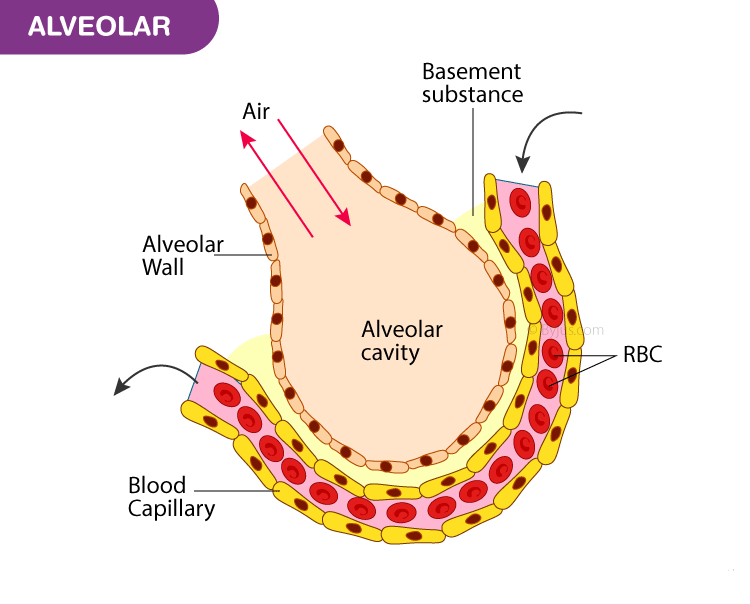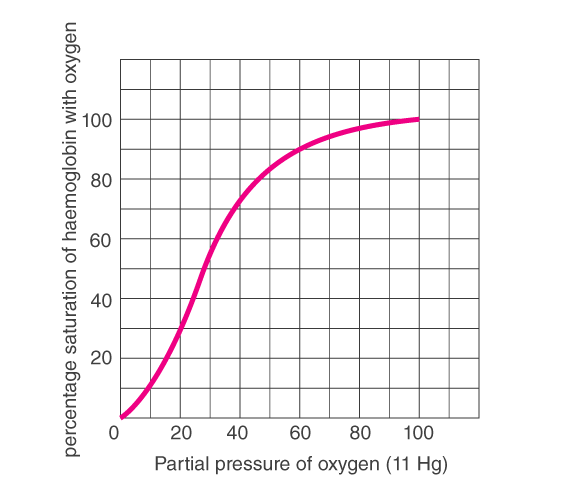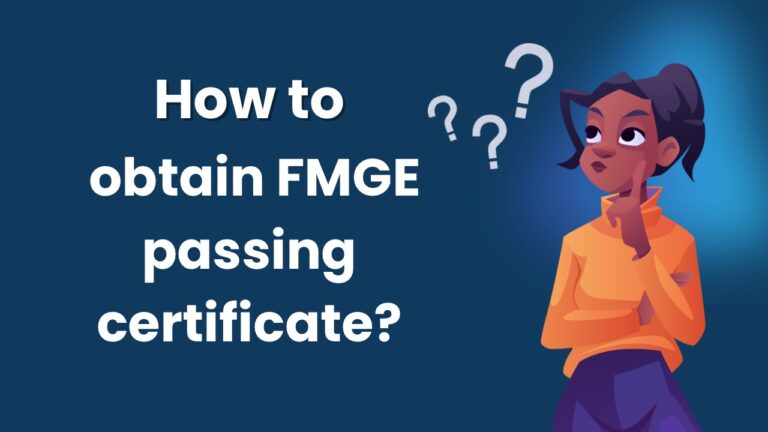NCERT Class 11 Biology Chapter 17 – Breathing and Exchange of Gases
1. Define vital capacity. What is its significance?
Solution:
Vital capacity can be defined as the maximum volume of air a person can breathe in post a force expiration.
Significance of vital capacity:
- It depicts the maximum amount of air that can be converted or renewed in the respiratory system in a single respiration
- The excess quantity of inhaled air represents the maximum amount of oxygen available for glucose-oxidation. This way more energy is available for the body.
2. State the volume of air remaining in the lungs after a normal breathing.
Solution:
It can be stated by the functional residual capacity (FRC). FRC is the volume of air that remains in the lungs after a normal expiration. The functional residual capacity is both the expiratory reserve volume (ERV) and residual volume (RV).
The expiratory reserve volume is the maximum volume of air which can be exhaled post a normal expiration which is approximately1000ml-1500ml. The residual volume is the volume of air that remains in the lungs after maximum expiration which is about 1100ml to 1500ml.
Hence,
FRC = ERV + RV
≅ 1500 + 1500 = 3000 ml
Thus, the functional residual capacity of the lungs in human beings is nearly 2500 ml to 3000 ml
3. Diffusion of gases occurs in the alveolar region only and not in the other parts of
respiratory system. Why?
Solution:
Alveoli are the small air sacs of the lungs that allow rapid gas exchange. These structures are specially built for the gas exchange process. The thickness of the alveolar membrane in total is lesser than a millimeter, while the outer surface of the alveolar membrane is in close proximity with the linkage of blood capillaries.

The endothelial membrane of the blood capillaries and the alveolar membrane is distinguished by a fine basement substance. This fine barrier facilitates easy diffusion of the gases. The alveolar air that comes in close proximity with the blood capillaries has higer levels of pO2 and lower levels of pCO2 that promote the gas-diffusion. All these structural pluses that are found in alveoli is not present in any other structure of the respiratory system. Therefore, the gas diffusion phenomena occurs in the alveolar region only and not in any other part.
4.What are the major transport mechanisms for CO2? Explain.
Solution:
Carbon dioxide is liberated by a vigorously active tissue in the blood. On an average, every 100ml of blood accepts approximately 3.7ml of CO2 from tissues.
In blood, carbon dioxide is carried in three forms:
- Carbon dioxide as a simple solutionNearly 5-10% of carbon dioxide of the total volume of blood is dissolved in plasma and is transported as a simple physical solution
- Carbon dioxide as a bicarbonate ionThe partial pressure of carbon dioxide at the tissue site is high due to catabolism. Carbon dioxide diffuses in the blood and forms carbonic acid after reacting with water. This reaction occurs in the presence of the carbonic anhydrase enzyme. The reaction is as follows:
 Carbonic acid dissociates into H+ ions and bicarbonate. Some amount of bicarbonate ions is required to sustain the pH of blood. The hydrogen ions are used by the proteins, the remaining bicarbonate ions are picked up by the plasma.
Carbonic acid dissociates into H+ ions and bicarbonate. Some amount of bicarbonate ions is required to sustain the pH of blood. The hydrogen ions are used by the proteins, the remaining bicarbonate ions are picked up by the plasma. - Carbon dioxide as carbamino-haemoglobinIn tissues, when the partial pressure of oxygen is lower and the partial pressure of carbon dioxide is higher, the carbon dioxide loosely combines with the globin part of the reduced haemoglobin so as to form carbamino-haemoglobin. The reaction is as follows:HbO2 + CO2 ⇌ HbCO3 + H+ + O2Oxyhaemoglobin carbamino-haemoglobin
At the alveolar level, when pO2 is higher and the pCO2 is lower, the carbon dioxide dissociates from carbamino-haemoglobin. Therefore, carbon dioxide that is bound to haemoglobin is liberated in the alveoli.
5. What will be the pO2 and pCO2 in the atmospheric air compared to those in the alveolar air?
(i) pO2 lesser, pCO2 higher
(ii) pO2 higher, pCO2 lesser
(iii) pO2 higher, pCO2 higher
(iv) pO2 lesser, pCO2 lesser
Solution:
The pO2 and pCO2 in the atmospheric air compared to those in the alveolar air will be:
(ii) pO2 higher, pCO2 lesser
In a mixture of gases, each gas exerts a pressure known as partial pressure. These gases always diffuse across the pressure gradient. Oxygen permeates easily into the lungs when the level of pO2 is higher in the atmosphere. Likewise, carbon dioxide can diffuse out of the body easily if the pCO2 level is lower in the atmosphere.
6.Explain the process of inspiration under normal conditions.
Solution:

The process by which fresh air enters into the lungs is known as inspiration. When the intrapulmonary pressure (pressure in the lungs) is lesser than the atmospheric pressure, inspiration takes place. The muscles of the diaphragm, external intercostal muscles and abdominal muscles are referred to as the inspiratory muscles which bring about the process of inspiration.
The muscles of the diaphragm contract, pulling the diaphragm downwards to the abdominal cavity, causing it to become flat which results in an increase in the thoracic cavity in the antero-posterior direction. The contraction of the external intercostal muscles, lifts up the ribs and the sternum resulting in the expansion of the thoracic chamber, in a dorso-ventral orientation.
This overall increase in the thoracic volume increases the pulmonary volume which inturn causes the decrease of pressure in the lungs. The atmospheric pressure expels air from outwards into the lungs. To compress the abdominal organs, the abdominal muscles relax that causes an escalation in the strength of the inspiration. During inspiration, air takes the following passage:

7.How is respiration regulated?
Solution:
The medulla region of the brain having the respiratory rhythm center, is chiefly responsible for the regulation process of respiration. The function performed by the respiratory rhythm center can be altered by the pneumotaxic center through signals to reduce the inspiration rate. The chemo sensitive area located near the respiratory centre is sensitive to hydrogen ions and carbon dioxide. This are sends signals to alter the rate of expiration to eliminate compounds.
The levels of carbon dioxide and hydrogen ions in the blood is detected by the receptors located in the carotid artery and the aorta. As and when the carbon dioxide level increases, the respiratory centre sends across nerve impulses for the required changes.
8. What is the effect of pCO2 on oxygen transport?
Solution:
pCO2 has a crucial role to play in the process of oxygen transport. As a result of low pCO2 levels in the alveoli, oxygen tends to bind with the hemoglobin, to form Oxyhaemoglobin. Higher levels of pCO2 in the tissues promotes the dissociation of Oxyhaemoglobin. The level of pCO2 is low at the surface of the lungs, here O2 binds with the haemoglobin and dissociates at the tissue grade, where the level of pCO2 is higher.
9. What happens to the respiratory process in a man going up a hill?
Solution:
As we go up higher, the altitude increases. At this altitude, the concentration of atmospheric oxygen is lesser, which means to say that the partial pressure of oxygen declines. This situation of inadequate oxygen-supply, demands more of oxygen. In order to increase the supply of oxygen to the blood, the man begins to breathe rapidly. Therefore, it causes an increase in the heart rate to be able to meet the demand of oxygen supply.
10.What is the site of gaseous exchange in an insect?
Solution:

The respiratory organs of insects is trachea. Trachea has openings known as spiracles through which air enters. Spiracles are located on either side of the abdomen of the insect. A pair of spiracles are found on each segment of the abdomen. Furthermore, the trachea branches into smaller tubes until they reach the level of tissues. The oxygen that enters the trachea is exchanged by diffusion with the tissues. Simultaneously, carbon dioxide that reaches the trachea from the tissues is forced out of the body.
11.Define oxygen dissociation curve. Can you suggest any reason for its sigmoidal pattern?
Solution:
A graph attained when the percentage saturation of haemoglobin with oxygen is plotted against the partial pressure of oxygen.

The affinity of the second molecule of oxygen escalates when the first molecule of oxygen binds to haemoglobin. This is why the Oxyhaemoglobin formation is rapid and is represented by the steep slope of the S-curve as observed. When the formation of Oxyhaemoglobin comes to a halt, or when haemoglobin molecules are not available for binding, the curve attains a plateau phase.
12. Have you heard about hypoxia? Try to gather information about it, and discuss with your friends.
Solution:
Hypoxia is a pathological condition wherein the body on the whole or a part of the body is not supplied with sufficient oxygen.
Hypoxia is of different types, namely:
- Cytotoxic hypoxia – caused by cyanide poisoning
- Anaemic hypoxia – caused by deficiency of haemoglobin
- Hypoxic hypoxia – caused due to insufficient oxygen in the atmosphere
- Stagnant hypoxia – caused by reduced pumping activity of the heart or heart failure
- Carbon monoxide poisoning – Irreversible binding of CO to haemoglobin and the reduced oxygen transport.
Symptoms:
- Shortness of breath
- Rapid heart rate
- Rapid breathing
- Anxiousness
- Lethargy
- Difficulty in communicating
- Confusion
Hypoxia is caused due to the following reasons:
- The concentration of oxygen is low at higher altitudes which may lead to hypoxia
- Hypoxia may also arise due to any of these respiratory disorders such as bronchitis, emphysema or asthma
- Hypoxia can also be caused due to anaemia which is linked to a lesser number of red blood cells
- It may arise due to heart problems such as tachycardia
13. Distinguish between
(a) IRV and ERV
(b) Inspiratory capacity and Expiratory capacity.
(c) Vital capacity and Total lung capacity.
Solution:
The differences are as follows:
(a) IRV and ERV
| IRV(Inspiratory reserve volume) | ERV(Expiratory reserve volume) |
| It is the volume of air that a person can additionally inspire through a compelled inspiration | It is the volume of air that a person can expire through an expelled expiration |
| For a healthy individual, the IRV is approximately 2500ml – 3000ml | For a healthy individual, the ERV is approximately 1000ml to 1100ml |
(b) Inspiratory capacity and Expiratory capacity
| Inspiratory capacity(IC) | Expiratory capacity(EC) |
| Inspiratory capacity is the volume of air that can be inhaled post a normal expiration | Expiratory capacity is the volume of air that be exhaled post a normal inspiration |
| It is given by the sum of tidal volume and the inspiratory reserve volumei.e, IC = TV + IRV | It is given by the tidal volume and the expiratory reserve volumei.e., EC = TV + ERV |
(c) Vital capacity and Total lung capacity
| Vital capacity(VC) | Total lung capacity(TLC) |
| After a maximum inspiration, it is the maximum volume of air that can be exhaled. It includes IC and ERV. | After maximum inspiration, it is the volume of air in the lungs. It includes ERV, IC and residual volume |
| The vital capacity in the lungs of humans is about 4000ml | The total lung capacity in the lungs of humans is nearly 5000ml to 6000ml |
14. What is Tidal volume? Find out the Tidal volume (approximate value) for a healthy human in an hour.
Solution:
During a normal respiration, the volume of air expired or inspired is referred to as tidal volume(TV). The tidal volume is approximately 500ml for a healthy individual. A healthy individual can expire or inspire nearly 6000-8000ml of air per minute or around 12-16 times a minute.
Hence, the tidal volume for a healthy man in an hour approximately can be between 3,60,000 ml and 4,80,000ml.
Frequently Asked Questions on Breathing and Exchange of Gases
Define vital capacity?
Vital capacity can be defined as the maximum volume of air a person can breathe in a post a forced expiration.
How is respiration regulated?
The medulla region of the brain having the respiratory rhythm center, is chiefly responsible for the regulation process of respiration. The function performed by the respiratory rhythm center can be altered by the pneumotaxic center through signals to reduce the inspiration rate. The chemo sensitive area located near the respiratory centre is sensitive to hydrogen ions and carbon dioxide. This area sends signals to alter the rate of expiration to eliminate compounds.
The levels of carbon dioxide and hydrogen ions in the blood is detected by the receptors located in the carotid artery and the aorta. As and when the carbon dioxide level increases, the respiratory centre sends across nerve impulses for the required changes.
What happens to the respiratory process in a man going up a hill?
As we go up higher, the altitude increases. At this altitude, the concentration of atmospheric oxygen is lesser, which means to say that the partial pressure of oxygen declines. This situation of inadequate oxygen-supply, demands more oxygen. In order to increase the supply of oxygen to the blood, the man begins to breathe rapidly. Therefore, it causes an increase in the heart rate to be able to meet the demand of oxygen supply.
Define oxygen dissociation curve?
A graph attained when the percentage saturation of haemoglobin with oxygen is plotted against the partial pressure of oxygen.
“>


